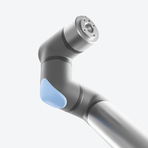Every manufacturer wants to create a quality product to keep customers satisfied and safe, but sometimes product quality is truly a life-and-death consideration. That’s the case with aircraft fuselage, where complete, accurate quality inspections are critical to assuring that the aircraft is safe before it takes to the skies.
Safer, More Cost-Effective Aircraft Manufacturing Processes

Every manufacturer wants to create a quality product to keep customers satisfied and safe, but sometimes product quality is truly a life-and-death consideration. That’s the case with aircraft fuselage, where complete, accurate quality inspections are critical to assuring that the aircraft is safe before it takes to the skies.
A typical infrared thermography inspection process involves generating a series of precise flashes of light against the fuselage, each of which creates a pulse of heat. As the material cools, researchers analyze how the heat flows through the part and interacts with internal elements to reveal hidden defects and sub-structures—all without damaging the fuselage. The inspection equipment is large and heavy, however, and must be moved across the entire surface of the fuselage inside and out to ensure that every image has been captured for a comprehensive inspection. Manual inspection of these large composite products requires multiple operators for extended time periods, which adds cost and complexity to the manufacturing process.
NASA’s advanced composite project is an effort to speed inspection of composite structures while also improving the results by ensuring that the inspection pattern doesn’t miss any areas. The NASA Langley Research Center is using a collaborative UR10 robot with a FLIR infrared inspection system and software from Universal Robots+ partner RoboDK to simulate and program the inspection pattern. With the robotic system, a single operator can oversee the inspection while the robot follows a pre-programmed path to move the inspection head into precise locations. The robot then holds the camera firmly in position while the operator retrieves the temperature data that reveals any structural or material defects.
With the RoboDK software, researchers can create a complete computer simulation of the product to be inspected, the inspection pattern, and the movement of the inspection tool (such as the infrared camera) before deploying the robot on-site. At inspection time, the program can be quickly downloaded to the robot and inspection can begin without any delays or additional setup. Programming the robot also ensures efficiency in inspection, as the program moves the robot on the most practical and comprehensive paths around the aircraft to make sure no areas are missed. Because RoboDK is a member of the UR+ development ecosystem, its simulation software has been fully tested and proven for compatibility and fast and easy integration with all UR robots.
The UR10’s built-in safety features allow people to work closely alongside the robot while it’s inspecting the aircraft. That allows other inspections or manufacturing processes to take place during the infrared inspection, which improves efficiency and saves time. The robot’s ease-of-use, programmability, and payload and reach capabilities make it ideal for a wide range of inspection types beyond infrared thermography, such as ultrasound or eddy current testing.
The long-term goal is to integrate this inspection system into the environment where fuselages are being manufactured, with minimal additional cost to the manufacturer, explained Elliott Cramer, Branch Head of Nondestructive Evaluation Sciences at NASA Langley Research Center. But there are additional long-term advantages as well. “The data that we record when the vehicle is manufactured can stay with the vehicle for its life,” Cramer said. “Because it was done robotically the first time, you know exactly where it was and you have the means to go back to that exact location and compare any changes that may be occurring during the life of the vehicle.”
Want to get your team on board with cobots? Download the free ebook now

- Universal Robots USA, Inc
- 27175 Haggerty Road, Suite 160
- 48377 Novi, MI

